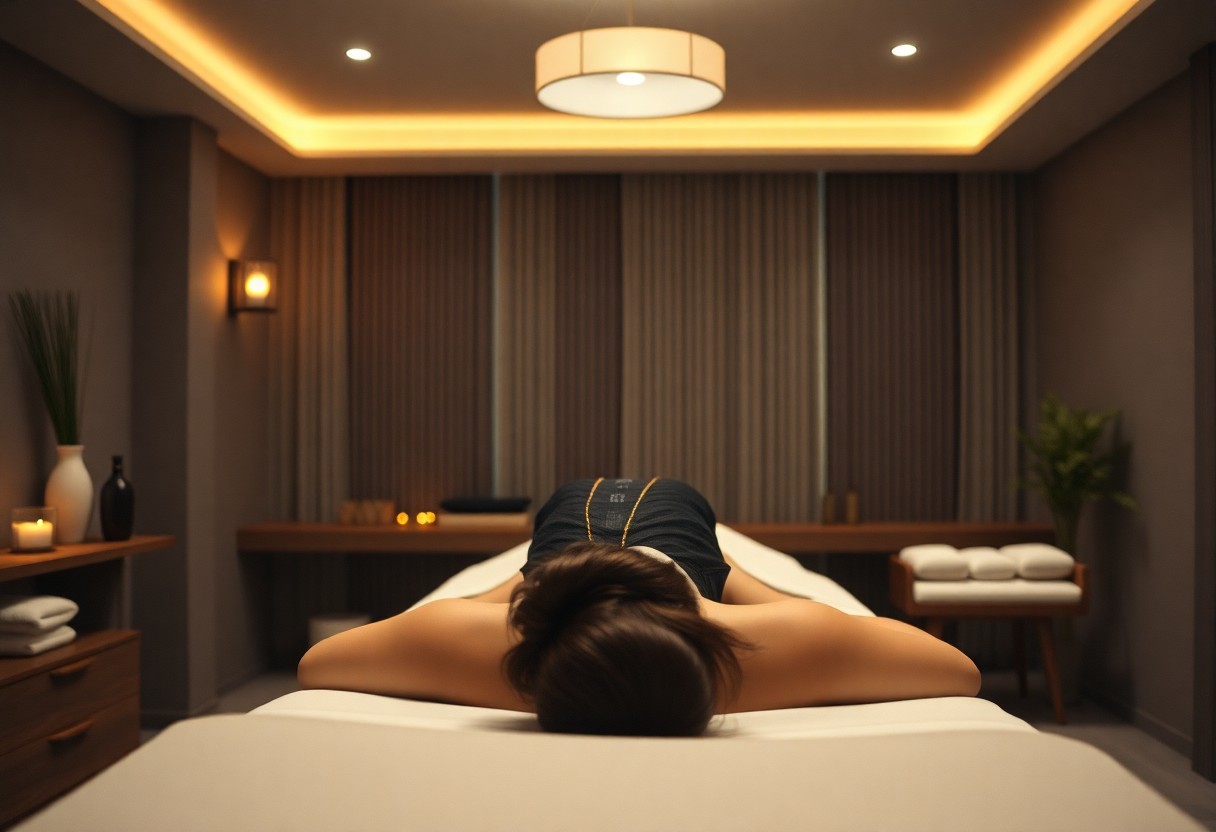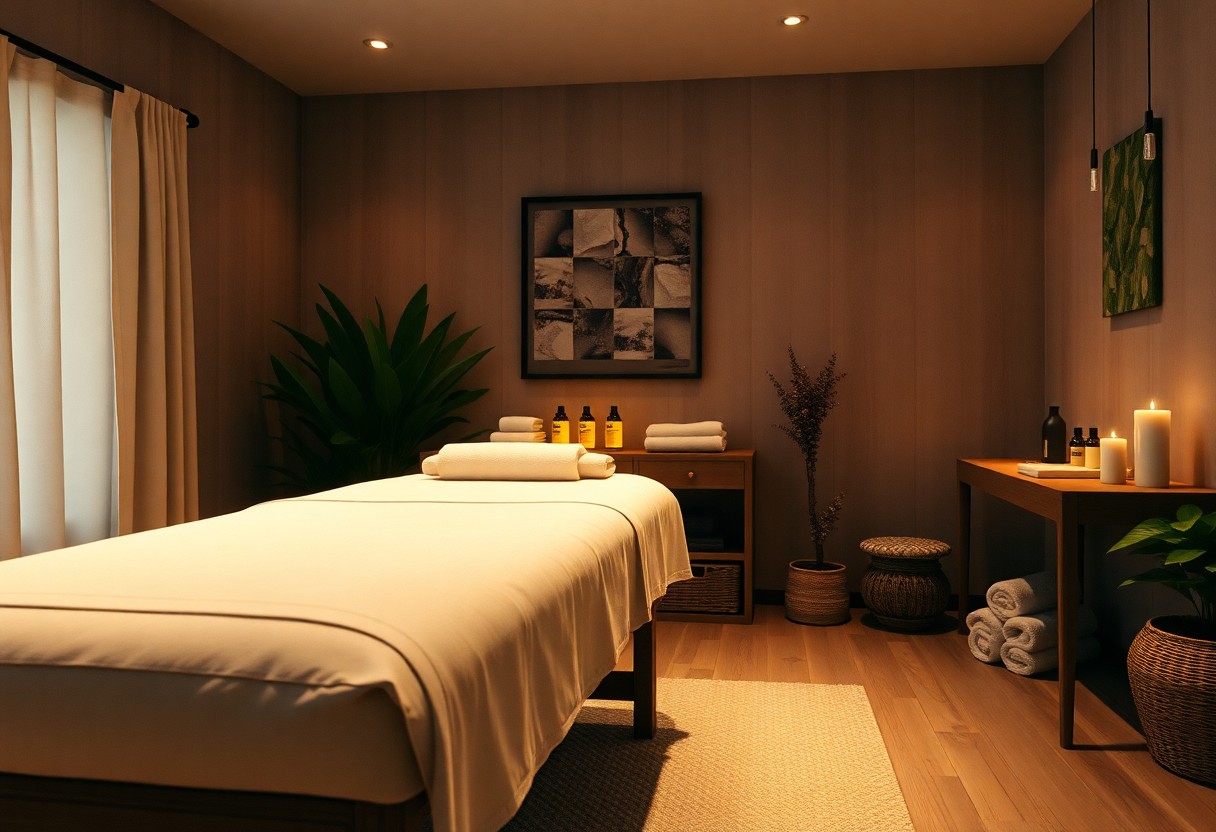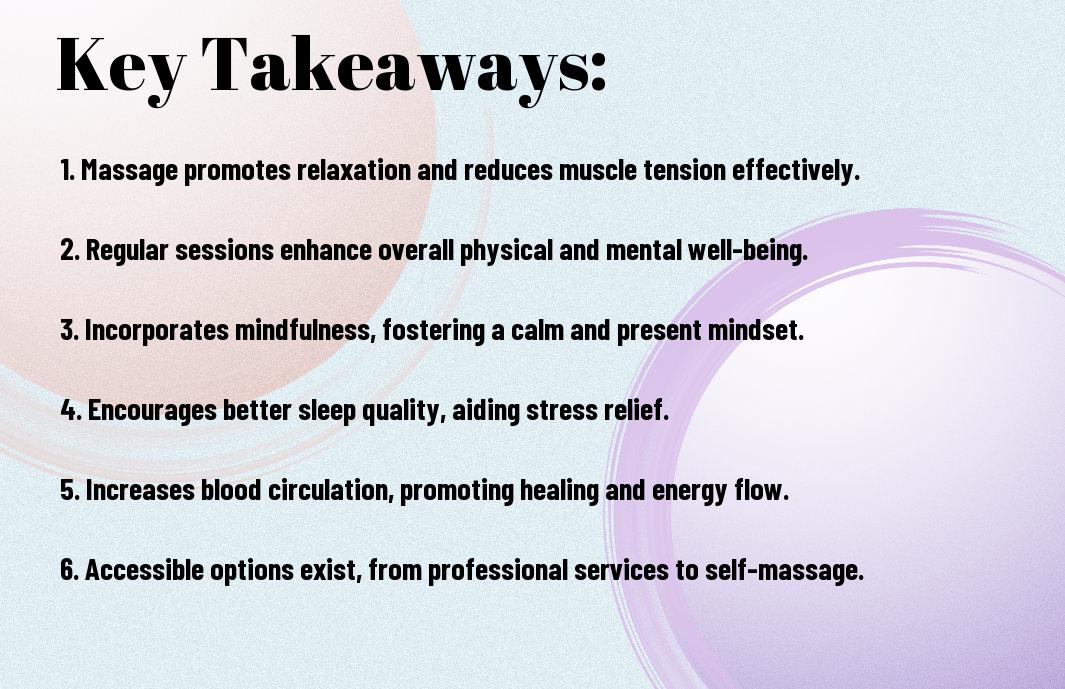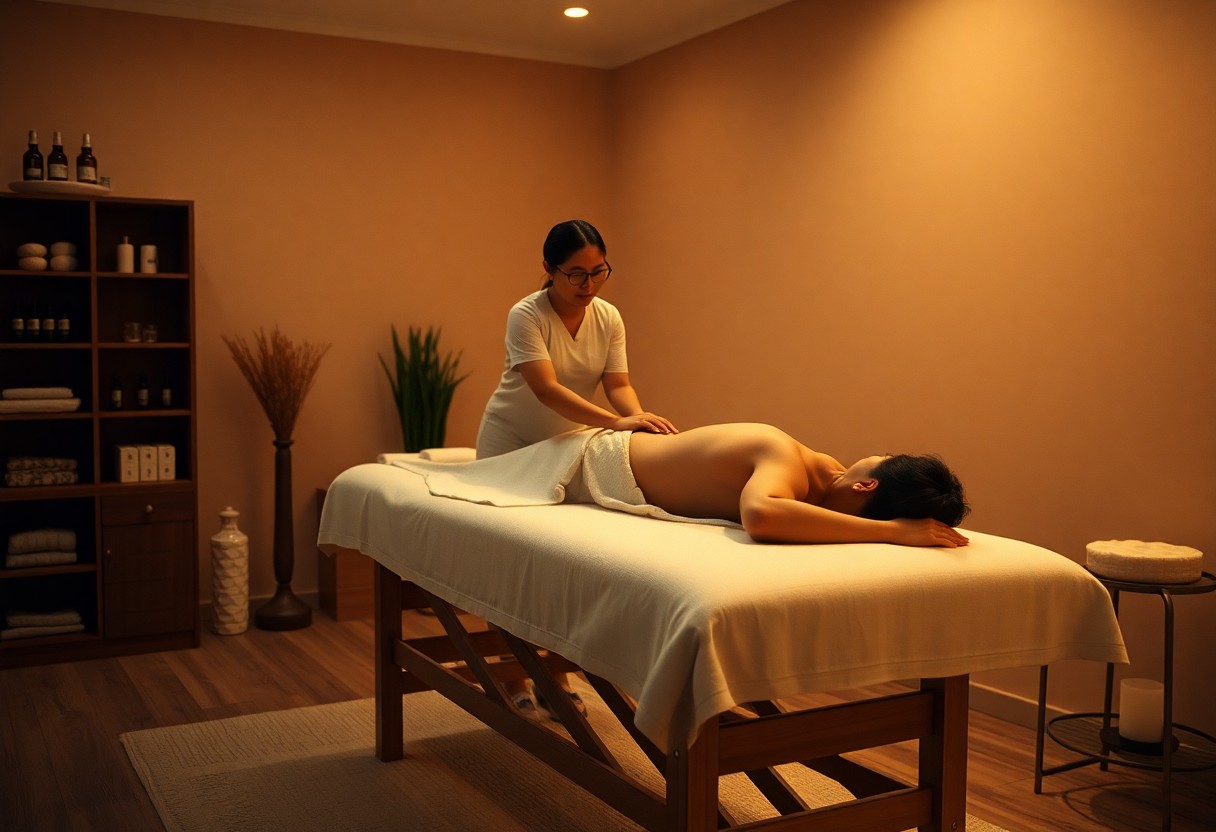Managing migraines can be challenging, but incorporating massage therapy into your routine may provide significant relief. By understanding how massage influences tension and circulation, you can discover effective techniques to ease your discomfort. This post will explore into various massage styles, their benefits specifically for migraine sufferers, and tips on how to incorporate them into your self-care practices. Explore the potential of massage as a valuable tool in your migraine management plan, allowing you to regain control over your pain and enhance your overall well-being.
Key Takeaways:
- Reduction of Tension: Massage therapy can help alleviate muscle tension and stress, which are common triggers for migraines.
- Improved Circulation: Regular massage can enhance blood flow, potentially reducing the frequency and intensity of migraine attacks.
- Enhanced Relaxation: Massage promotes relaxation and decreases anxiety, contributing to a calming effect on the nervous system.
- Pain Relief: Targeted massage techniques can provide immediate relief from pain associated with migraines.
- Holistic Approach: Integrating massage into a migraine management plan can complement other treatments and lifestyle changes for better overall results.
Understanding Migraines
Before stepping into managing migraines, it’s important to grasp what they are. Migraines are intense, often debilitating headaches that can last for hours or even days. They can affect not only your head but also your overall well-being, as they are frequently accompanied by nausea, sensitivity to light and sound, and other symptoms. Understanding the nature of migraines is the first step toward finding effective treatments and relief methods.
Causes and Triggers
Before exploring treatment options, identifying potential causes and triggers for your migraines is necessary. Various factors can contribute to the onset of migraines, including hormonal changes, stress, certain foods, lack of sleep, and environmental stimuli. Keeping a detailed headache diary can help you recognize patterns and pinpoint what exacerbates your condition.
Symptoms and Phases
Against the backdrop of understanding migraines, it’s necessary to recognize the symptoms and phases they undergo. Migraines typically progress through four phases: prodrome, aura, headache, and postdrome. Each phase presents different symptoms, from subtle changes in mood or energy to severe pain and exhaustion following an attack.
In fact, during the prodrome phase, you might experience mood swings, fatigue, or cravings, serving as your body’s warning that a migraine is approaching. The aura phase can involve visual disturbances or sensory changes, indicating that pain is imminent. When the headache phase occurs, it can be intense and debilitating. Finally, the postdrome phase often leaves you feeling drained and mentally foggy, making it difficult to return to your daily activities. Understanding these phases can enhance your ability to manage your migraines more effectively.
The Science Behind Massage Therapy
Clearly, massage therapy is rooted in scientific principles that highlight its efficacy in alleviating migraine symptoms. Research shows that massage can influence the body’s neurochemistry, significantly lowering levels of cortisol and enhancing the production of serotonin. These changes can lead to reduced pain and diminished migraine frequency, making massage therapy a viable complement to conventional migraine management techniques. Additionally, the physical manipulation of muscles and tissues can improve circulation and relieve tension, further contributing to your overall sense of wellness.
Physiological Benefits
One significant aspect of massage therapy is its physiological benefits. Regular sessions can help alleviate muscle tension, reduce inflammation, and improve blood flow, which are all important factors in migraine management. Enhanced circulation ensures that oxygen and nutrients are effectively delivered to your muscles and tissues, supporting recovery and relaxation. Consequently, you may notice fewer episodes of migraine as your body becomes more adept at handling stressors and physical discomfort.
Psychological Benefits
On the psychological side, massage therapy offers noteworthy advantages that can impact your experience with migraines. The soothing nature of massage helps to promote relaxation and alleviate stress, which are often triggers for migraine headaches. Through gentle touch and targeted pressure, you can activate the body’s relaxation response, leading to lower anxiety levels and improved emotional well-being.
Physiological response to massage does not only encompass physical relaxation; it also plays a vital role in your mental state. By engaging in regular massage therapy, you can cultivate mindfulness and enhance your emotional resilience. The tranquil environment during a session encourages introspection, helping you process stressors that may contribute to migraines. Ultimately, addressing both the physical and psychological dimensions of your health can equip you with the tools necessary for better migraine management.
Types of Massage Techniques for Migraines
For effective migraine management, various massage techniques can be employed to alleviate pain and tension. You can explore these options:
- Swedish Massage
- Trigger Point Therapy
- Deep Tissue Massage
- Aromatherapy Massage
- Shiatsu Massage
Assume that each technique addresses different aspects of your migraine, offering tailored relief according to your specific needs.
| Massage Technique | Description |
| Swedish Massage | Gentle strokes to relax and improve circulation. |
| Trigger Point Therapy | Targets tight knots in muscles for pain relief. |
| Deep Tissue Massage | Focuses on deeper layers of muscle and connective tissue. |
| Aromatherapy Massage | Incorporates necessary oils to enhance relaxation. |
| Shiatsu Massage | Uses finger pressure on specific points to relieve tension. |
Swedish Massage
On experiencing a Swedish massage, you will find the application of gentle, flowing strokes designed to relax your body and enhance blood flow. This technique helps release muscle tension and promotes overall relaxation, making it an excellent choice for migraine sufferers seeking relief from stress and discomfort.
Trigger Point Therapy
Across the landscape of massage techniques, trigger point therapy stands out for its targeted approach in relieving migraine pain. This method involves applying direct pressure to specific knots in your muscles, which can often be the source of referred pain associated with migraines.
And understanding trigger point therapy can deepen your relief experience. By focusing on areas where muscle tension creates discomfort, you can achieve significant reduction in pain and improve your overall sense of well-being. This precision makes it a valuable tool in your migraine management toolkit, ensuring effective treatment tailored to your specific pain points.
Evidence and Research on Massage Efficacy
To understand the effectiveness of massage in managing migraines, numerous studies have explored its benefits. Research findings indicate that massage therapy can reduce the frequency, intensity, and duration of migraine attacks, providing a non-pharmaceutical option for treatment. By promoting relaxation and improving circulation, massage may help alleviate the tension that often triggers migraines, making it a valuable addition to your management plan.
Clinical Studies
After reviewing various clinical studies, you will find compelling evidence supporting the role of massage therapy in migraine management. Certain trials have reported significant reductions in headache days among participants receiving regular massage treatment compared to control groups. These studies often highlight how massage reduces muscle tension and enhances mood, which can make a substantial difference in your overall experience with migraines.
Patient Testimonials
About the experiences of those who have incorporated massage into their migraine management routine, many individuals share positive outcomes. Patients frequently report feeling more relaxed and less susceptible to migraine triggers after receiving massage therapy. Such testimonials can serve as a motivating factor for you to explore this alternative approach in your quest for relief.
Efficacy of massage as described in patient testimonials is often linked to the subjective experience of relief and well-being. Many individuals express a noticeable reduction in stress levels, describing how regular sessions can create a sense of empowerment in managing their condition. While personal experiences may vary, these accounts highlight the potential of massage therapy in enhancing your quality of life while dealing with migraines.
Integrating Massage into Migraine Management
Unlike many conventional treatments, massage therapy can provide a holistic approach to managing migraines. By incorporating regular massage into your routine, you can help release tension in the muscles, improve circulation, and promote relaxation. This practice not only addresses the physical symptoms associated with migraines but also contributes to a greater sense of overall well-being.
Professional vs. Self-Massage
Professional massage therapy offers the advantage of targeted techniques carried out by trained practitioners who understand your specific migraine triggers and needs. However, self-massage can also be beneficial, providing you with immediate relief and the ability to focus on areas that are most tense. Both options have their place in your migraine management plan.
Recommended Frequency
Against the belief that occasional massage is sufficient, establishing a consistent massage routine can enhance its effectiveness in alleviating migraine symptoms. Aim for sessions once or twice a month to reap optimal benefits.
Migraine management is often most successful with regular attention to muscle tension and stress relief. It’s advisable to consider scheduling a massage at least once every three to four weeks, or even more frequently during migraine flare-ups. This consistent practice can help your body adapt and respond better to massage, decreasing the frequency and intensity of migraines over time.
Precautions and Considerations
Now you should be aware that while massage may provide relief from migraines, it’s important to approach it thoughtfully. Consider your individual health status and the severity of your symptoms before scheduling a session. Being informed about potential side effects and contraindications can help you maximize the benefits while minimizing risks associated with your treatment.
When to Avoid Massage
With certain conditions such as acute migraines, infections, or skin diseases, it may be advisable to avoid massage. If you are experiencing severe pain or other symptoms that accompany migraines, it’s best to consult a healthcare provider before proceeding with any massage therapy. Your safety and well-being should always come first.
Consultation with Healthcare Providers
With any new therapy, you should consult your healthcare provider to discuss your migraines and how massage may fit into your treatment plan. Professional guidance ensures you receive personalized recommendations based on your unique health history and circumstances.
Consequently, having an open conversation with your healthcare provider allows you to explore the potential benefits of massage therapy in managing your migraines while considering any contraindications. This conversation is an opportunity to align your goals with your treatment options. Your provider can offer insights on the most suitable massage styles for you and may even recommend experienced therapists who specialize in headache management. Prioritizing this step will help you on your journey to a more manageable migraine experience.
Summing up
On the whole, incorporating massage into your migraine management routine can provide significant relief and improve your overall quality of life. By reducing muscle tension and promoting relaxation, massage can alleviate some of the triggers associated with migraines. You may find that regular sessions enhance circulation and ease headaches, supporting your journey toward better health. Always consult with a healthcare professional before starting any new treatment, and consider integrating massage therapy as a complementary approach to your migraine management plan.
Q: How can massage therapy help alleviate migraine symptoms?
A: Massage therapy can help alleviate migraine symptoms by reducing muscle tension and improving circulation in the body. Tension in the neck, shoulders, and head can often contribute to the severity of migraines. Through targeted techniques, such as Swedish or deep tissue massage, a therapist can relieve muscle tightness and promote relaxation. Additionally, massage can trigger the release of endorphins, which are natural pain relievers, and may help reduce the frequency and intensity of migraine attacks.
Q: Are there specific massage techniques that are more effective for migraines?
A: Yes, certain massage techniques can be particularly effective in addressing migraines. Trigger point therapy, for example, focuses on specific areas of tension in the muscles that may cause referred pain, such as in the head or neck. Other beneficial techniques include myofascial release, which targets fascia to alleviate pressure points, and craniosacral therapy, which gently manipulates the skull and spine. Combining these techniques can create a tailored approach that addresses individual pain sources and enhances overall relaxation.
Q: How often should someone with migraines seek massage therapy for best results?
A: The frequency of massage therapy for migraine management can vary based on individual needs and the severity of the condition. For some, weekly sessions may be beneficial, especially during acute phases of migraines, while others may find relief with bi-weekly or monthly treatments. It is advisable to consult with a healthcare professional or a licensed massage therapist to establish a personalized treatment plan. Consistency, along with other self-care practices, can contribute to better overall management of migraines.





